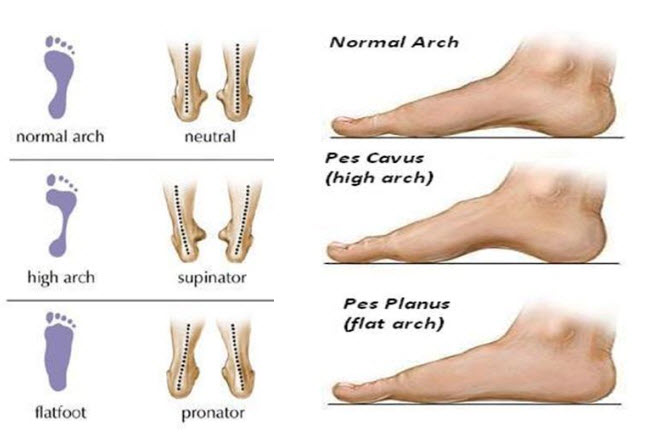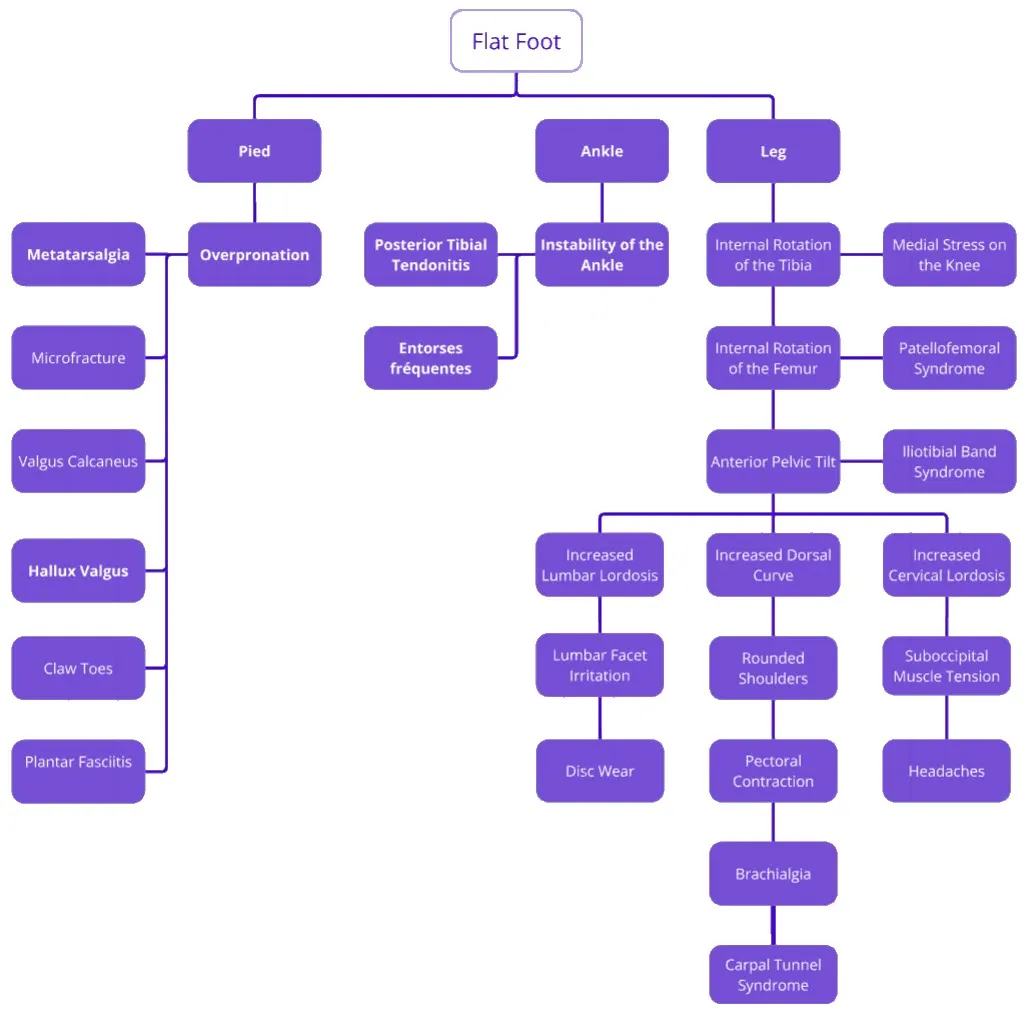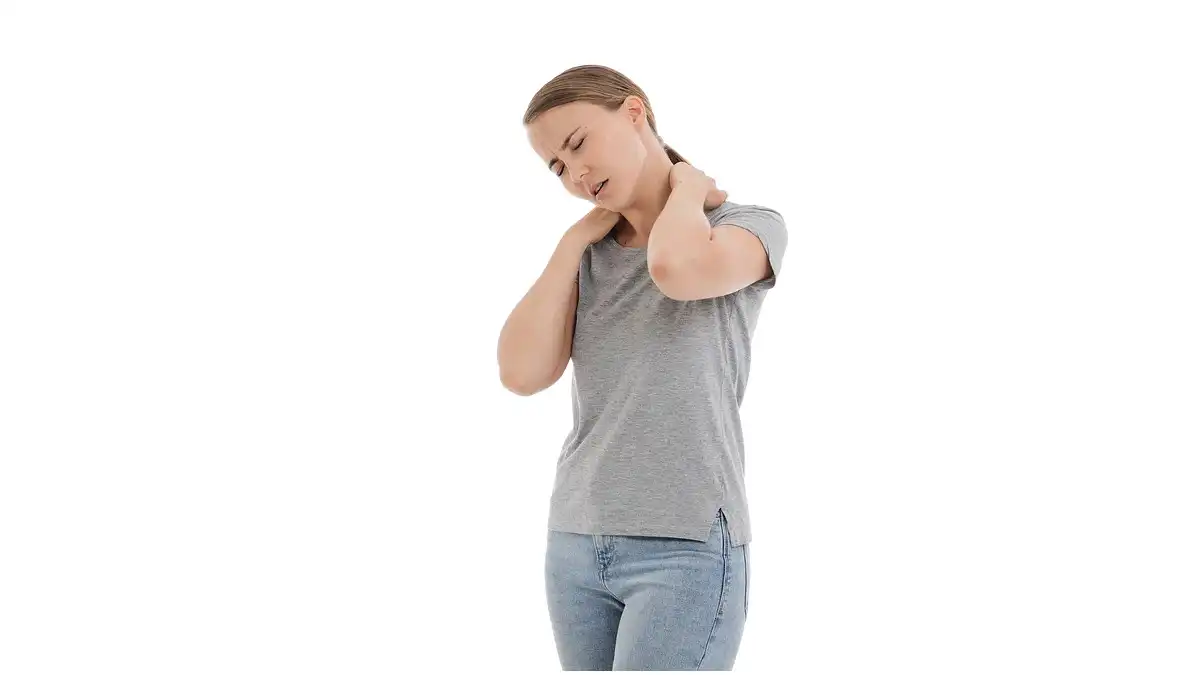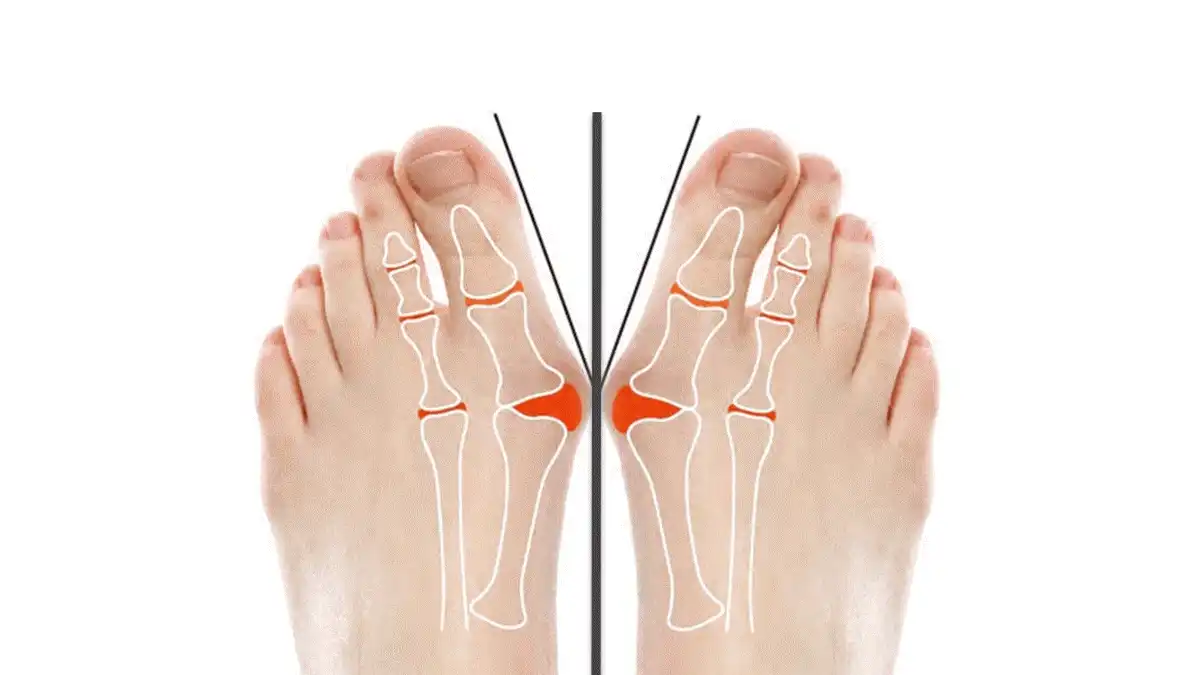Flat foot, also known as pes valgus, is a condition in which the arch of the foot is less pronounced, leading to increased contact of the foot with the ground.
Introduction
Flat feet, also known as pes valgus, is a common podiatric condition characterized by a decrease or absence of the longitudinal arch of the foot. It can occur in early childhood or develop over time in adults. Flat feet can be hereditary or result from factors such as injury, obesity or underlying medical conditions.
One of the main concerns with flat feet is insufficient arch support, which can lead to problems such as foot pain, knee pain, hip pain, and back pain. People with this condition may also experience increased fatigue when walking or running.
Treatment for flat feet depends on the severity of the symptoms and the underlying cause. Non-invasive options include wearing appropriate shoes with good arch support and using orthotic insoles. Foot and ankle muscle strengthening exercises may also be recommended to improve stability.
In some more serious cases, surgery may be considered to reconstruct or repair the ligamentous structures that support the arch of the foot. However, most people with flat feet can manage their symptoms with conservative measures.
It is essential to raise awareness about flat feet and promote preventive practices such as wearing appropriate shoes from a young age. Parents should be alert to signs of flat feet in their children, such as rapid fatigue when walking or complaints of foot pain.

Classification
Flexible flat foot (correctable)
Flexible flatfoot, also called correctable flatfoot, is a condition in which the arch of the foot collapses when there is pressure placed on the foot, but it can usually return to its normal shape when the weight is removed. Unlike the rigid flatfoot which maintains a flat arch at all times, the flexible flatfoot allows some flexibility of the arch depending on the movements and loads applied.
Here are some features of the flexible flat foot:
- Temporary Sagging: When the person stands or walks, the arch of the foot may sag, giving the appearance of a flat foot. However, it can return to its normal shape when the weight is removed.
- Flexibility: The flexible flat foot is associated with a certain flexibility in the arch of the foot, which allows the foot to adapt to the different pressures exerted during walking or running.
- Absence of Pain: In many cases, people with flexible flatfoot do not experience pain associated with the condition. However, some people may experience mild discomfort or increased fatigue.
- Common in Children: Flexible flatfoot is common in children due to the continued development of musculoskeletal structures. In some children, the arch of the foot fully develops as they grow.
- Can Be Temporarily Corrected: Using supportive shoes, orthotics, or muscle-strengthening exercises can help temporarily correct the arch of the foot during activities.
Rigid flat foot (non-correctable)
Rigid flatfoot, also called uncorrectable flatfoot, is a condition in which the arch of the foot is permanently flat and cannot be straightened or corrected, even when the foot is lifted off the ground. Unlike the flexible flat foot, where the arch of the foot can collapse when weight is removed from the foot, the rigid flat foot maintains a flat position regardless of the pressure placed on the foot.
Here are some characteristics of the rigid flat foot:
- Absence of Plantar Arch: The plantar arch remains flat at all times, even when no pressure is exerted on the foot.
- Rigidity: Unlike the flexible flat foot which can sometimes show an arch when sitting or standing on the toes, the rigid flat foot remains rigid in all circumstances.
- Discomfort or Pain: People with a rigid flat foot may experience discomfort or pain in the foot, ankle, or even leg area, due to the lack of arch support.
- Mobility Issues: Arch stiffness can lead to mobility and balance issues, affecting gait and foot stability.
- Underlying Conditions: Rigid flatfoot can sometimes be associated with underlying conditions, such as bone abnormalities, joint problems, or neuromuscular disorders.
- Management: Management of rigid flat foot may include measures to relieve pain and improve stability, such as wearing supportive shoes, using custom orthotics, and in some cases, corrective surgical procedures.
Rigid flatfoot develops in adults (adult acquired flatfoot) due to weakening of the tendon of the posterior tibial muscle (major support structure of the arch of the foot). The fall of the arch of the foot will be gradual and will lead to pain and swelling in the ankle which can eventually lead to arthritis of the joints of the foot and ankle.
Acquired flat foot
Acquired flatfoot, also called adult-acquired flatfoot, refers to a condition where the arch of the foot that was normally present becomes collapsed over time, usually in adulthood. Unlike congenital flatfoot, where the person is born with an underdeveloped arch of the foot, acquired flatfoot develops later in life.
Here are some factors that can contribute to the development of acquired flat foot:
- Age: Aging can cause tendons and ligaments to have less flexibility, which can contribute to a sagging arch.
- Joint Wear: Normal wear and tear on joints from physical activity, repetitive movements or medical conditions can weaken the supporting structures of the foot.
- Injuries: Injuries to the feet, ankles, or legs can affect the supporting structures of the foot and contribute to the development of acquired flatfoot.
- Ligament Laxity: Increased laxity of the ligaments can lead to sagging of the arch of the foot.
- Arthritis: Certain types of arthritis can affect the joints of the foot, leading to a weakening of the arch of the foot.
- Obesity: Excess weight can put extra pressure on the feet, contributing to a sagging arch.
- Intense Physical Activities: Certain strenuous physical activities or participation in high-impact sports can increase the risk of developing acquired flatfoot.

Normal Arch (Neutral): Shows a foot with a well-balanced, neutral arch. The heel alignment is straight, and there is a clear arch in the middle of the foot.
Pes Cavus (High Arch – Supinator): Demonstrates a foot with a high arch, often leading to a supinated (outward) alignment. In this case, the heel curves inward, and the arch is exaggerated.
Pes Planus (Flat Arch – Pronator): Illustrates a flatfoot condition where the arch collapses, causing a pronated (inward) alignment. The heel rolls inward, and the arch is minimal or absent.
Sign of excess toes
The “excess toes sign” is a clinical observation which is sometimes involved in the evaluation of the degree of pronation of the foot and the possible presence of a flat foot. To spot this sign, we usually examine the foot from behind, focusing on the number of toes visible on the lateral (outer) side compared to the medial (inner) side. This observation may indicate excessive pronation and highlight possible problems with the arch of the foot.

In normal alignment of the foot, when viewed from the rear, we should normally see the fourth toe and sometimes the fifth. The presence of more toes, especially the first and second, suggests excessive pronation, that is, excessive inward movement of the foot. This increased pronation may be associated with conditions such as flat foot.
In summary, the “excess toes sign” is based on observing the number of toes visible when looking at the foot from behind. If more than the fourth and fifth toes are distinguishable, especially the first and second toes, this may indicate excessive pronation and a lower arch characteristic of flat feet.
It is crucial to emphasize that although the “excess toe sign” can provide useful guidance, it is only one component in diagnosing flat foot or other foot conditions. A comprehensive evaluation by a healthcare professional, such as a podiatrist or orthopedic specialist, including a thorough physical examination, gait analysis, and possibly imaging studies, remains essential for an accurate diagnosis and appropriate treatment recommendations.
Causes of flat foot
Flat feet can be caused by a variety of factors, including genetic, anatomical, muscular, or related to health conditions. Here are some of the common causes of flat foot:
- Genetics: A genetic predisposition can play an important role in the development of flat feet. If family members have flat feet, there is an increased risk of developing this condition.
- Insufficient Muscle Development: Insufficient muscle development in the foot and ankle region can contribute to flat feet. The muscles of the foot and leg play a crucial role in maintaining the arch of the foot.
- Injuries or Strain: Repeated injuries or strain to the feet, ankles, or legs can weaken the muscles that support the arch of the foot, contributing to the development of flat feet.
- Growth Issues: Certain growth issues in childhood can influence foot development. For example, abnormal bone growth can affect the structure of the foot.
- Arthritis: Some forms of arthritis, such as rheumatoid arthritis, can affect the joints of the foot, leading to deformity and eventually flat feet.
- Ehlers-Danlos Syndrome: It is a genetic disorder of the connective tissue that can influence the structure of the feet, among other symptoms.
- Obesity: Excess weight can put extra pressure on the feet, weakening the muscles and contributing to the development of flat feet.
- Age: Flat feet can develop with age as ligaments and tendons lose their natural elasticity.
- Neurological Conditions: Neurological conditions, such as cerebral palsy, can affect muscle tone and contribute to the development of flat feet.
It is important to note that flat feet can be asymptomatic in many people and do not always require treatment.
Symptoms of flat foot
Flat feet, also known as pes valgus, can be asymptomatic in many people, but some people may experience symptoms associated with this condition. Symptoms of flat foot can vary in intensity and may include:
- Pain: Pain is one of the most common symptoms associated with flat feet. It can appear on the inside of the ankle, along the arch of the foot, the heel or even in the calf. The pain can be mild to severe, especially after physical activity.
- Foot and Leg Fatigue: People with flat feet may experience increased fatigue in their feet and legs, especially after a long period of walking or standing.
- Discomfort or Heavy Feeling: Some individuals may experience a feeling of discomfort or heaviness in the feet, particularly towards the end of the day.
- Instability or Twisting Sensation: People with flat feet may experience a feeling of instability or twisting in their feet, especially when walking or standing for long periods of time.
- Difficulties Finding Comfortable Shoes: People with flat feet may have difficulty finding comfortable shoes that provide adequate arch support.
- Calluses or Corns: Due to increased pressure on certain parts of the foot, calluses or corns may develop, especially on the soles of the feet.
- Heel Pain (Plantar Fasciitis): People with flat feet have an increased risk of developing plantar fasciitis, which can lead to heel pain, especially when taking their first steps in the morning.
- Posture Issues: Flat feet can also contribute to posture issues, which can lead to pain in the knees, hips, and back.
Pathophysiology of Flat Foot
The pathophysiology of flatfoot, step by step, involves a number of complex mechanisms that can vary depending on the type of flatfoot (flexible, rigid) and individual factors. Here is a simplified explanation of the main stages of the pathophysiology of flat foot:
- Resting Arch Failure: The normal arch of the foot exhibits a slight curvature when an individual is in a standing position. In the case of flat foot, this arch is collapsed, even when resting, resulting in a flatter appearance under the sole of the foot.
- Collapse of the Arch during Loading: When body weight is applied to the foot, the arch of the foot can collapse further. In flexible flatfoot, this sagging may be temporary, and the arch may return to its normal shape when the pressure is removed.
- Muscle Weakness: Strength in the muscles of the foot and ankle, particularly the tibialis posterior muscle, is essential for maintaining the arch of the foot. Muscle weakness can contribute to arch collapse.
- Ligament Laxity: Excessive laxity of the ligaments can allow abnormal movement of the joints of the foot, thereby contributing to arch collapse.
- Hyperpronation: When the arch of the foot collapses excessively, it can lead to hyperpronation, which is excessive inward rolling of the foot when walking or running.
- Change in Load Distribution: Due to the change in the structure of the foot, the load distribution during walking may be altered, leading to increased pressure on certain parts of the foot.
- Impact on Adjacent Joints: Changes in the structure of the foot can impact adjacent joints, such as the ankle, knees and hips, contributing to pain and mobility issues.
- Development of Complications: Over time, untreated flat foot can lead to the development of complications, such as plantar fasciitis, joint problems and premature shoe wear.
The pathophysiology of flat foot is influenced by genetic, anatomical, muscular and environmental factors. Treatment will depend on the severity of symptoms and may include conservative interventions, such as wearing supportive shoes, orthotics, muscle strengthening exercises, or in some cases, surgery.
A Day in the Life of Someone Suffering from Having Flat Foot
7:00 AM: Waking Up with Stiffness
Mark, a 35-year-old office worker, wakes up with a familiar sense of stiffness and discomfort in his feet. For someone with flat feet, the mornings often start with pain, as his arches provide inadequate support. As he gets out of bed, Mark carefully stretches his feet, hoping to alleviate some of the tightness that has accumulated overnight. The condition, known as flat foot or pes planus, means that the arches of his feet are lower than usual, leading to discomfort and imbalance.
8:00 AM: Navigating the Morning Routine
Getting ready for work is a calculated process for Mark. He chooses footwear with extra support and custom orthotics, which help to reduce the strain on his arches. Even with these adjustments, standing for prolonged periods can be challenging. In the shower, Mark uses a mat to provide extra cushioning, and while preparing breakfast, he sits on a stool to avoid standing too long. These small changes make a significant difference in managing the pain.
9:00 AM: The Commute
Mark’s daily commute involves a short walk to the bus stop. This seemingly simple task becomes more arduous because of his flat feet. Walking on hard surfaces without proper arch support can lead to pain that radiates up his legs, affecting his knees and lower back. He’s learned to pace himself, walking slowly and deliberately to minimize discomfort. Mark’s backpack is packed lightly, as additional weight can exacerbate the pain.
10:00 AM: Office Challenges
Upon arriving at the office, Mark faces the first challenge of his workday: sitting at his desk for long periods. Though sitting relieves some pressure from his feet, staying in one position too long can lead to stiffness and discomfort. To manage this, Mark takes regular breaks to stretch and walk around. His ergonomic desk chair provides additional lumbar support, helping him maintain proper posture and alleviate back pain.
12:00 PM: Lunchtime Relief
Lunch offers a welcome break from sitting. Mark takes this opportunity to walk to a nearby park, where he can stretch his legs and get some fresh air. He practices specific exercises recommended by his physiotherapist to strengthen his foot muscles and improve flexibility. These exercises help manage his condition and prevent the pain from worsening. While others might overlook such routines, they are essential for Mark’s well-being.
3:00 PM: Afternoon Fatigue
As the afternoon progresses, fatigue sets in. The constant strain on Mark’s feet and legs makes it difficult to maintain focus. He experiences pain that shoots up his shins, a common symptom for those with flat feet. Mark employs techniques such as seated calf raises and foot massages to manage his discomfort, knowing that self-care is crucial in preventing further issues.
5:00 PM: Heading Home
The journey home is much like the morning commute, a test of patience and resilience. Mark stops by a grocery store, mindful of the weight he carries. Choosing ingredients for a simple dinner, he focuses on maintaining a balanced diet that supports his overall health. The walk back home, though brief, serves as a reminder of the continuous battle he faces against flat foot pain.
6:30 PM: Evening Exercise
In the evening, Mark heads to the local gym for a workout tailored to his condition. He focuses on low-impact exercises such as cycling and swimming, which strengthen his leg muscles without putting undue pressure on his arches. The gym provides a sense of accomplishment, reminding Mark that, despite his flat feet, he can still lead an active lifestyle. Exercise is a vital component of his routine, offering both physical and mental benefits.
9:00 PM: Relaxation and Reflection
As the day winds down, Mark finds solace in relaxing at home. He practices mindfulness meditation to manage the stress and anxiety associated with chronic pain. This time for reflection helps him maintain a positive outlook despite the challenges. Mark is hopeful about the future, knowing that with consistent care and attention, he can manage his condition effectively.
11:00 PM: Preparing for Rest
Mark prepares for bed, knowing that restful sleep is crucial for his recovery. He elevates his feet with pillows to reduce swelling and reviews his daily routine, considering any adjustments needed for tomorrow. Despite the difficulties, Mark remains resilient, understanding that his flat feet do not define him but rather highlight his strength and determination.
Complications of Flat Foot: A Chain Reaction
Flat foot, or pes planus, not only affects the foot itself but can lead to a series of biomechanical complications throughout the body. The collapse of the foot’s arch disrupts the alignment of the legs, pelvis, and spine, triggering a chain reaction that can affect joints, muscles, and tendons from the tibia to the occiput. The key to understanding these complications lies in the interconnectedness of the musculoskeletal system and how a problem in one area, such as the feet, can cascade upward, impacting other structures.
Internal Tibial and Femoral Torsion
When the arches of the foot collapse, it causes the foot to pronate, meaning the ankle rolls inward. This inward rotation of the foot alters the alignment of the tibia (shinbone), leading to internal tibial torsion. This torsion creates abnormal stress on the knee joint, forcing it to compensate for the misalignment. As the tibia twists inward, the femur (thigh bone) follows suit, resulting in internal femoral torsion. This rotation at both the tibial and femoral levels places considerable strain on the knee, which can lead to patellofemoral pain syndrome (pain around the kneecap), and wear down the cartilage, potentially contributing to osteoarthritis over time.
Knee Complications
The abnormal inward rotation of the tibia and femur causes the knee joint to experience excessive pressure and mechanical imbalance. This misalignment shifts the load away from the knee’s natural shock-absorbing mechanisms, leading to strain on the ligaments and tendons around the joint. Over time, this can cause issues such as medial knee pain and meniscal damage, increasing the risk of injury and degenerative changes. The knee’s altered biomechanics can also lead to iliotibial (IT) band syndrome, a painful condition in which the IT band, a thick band of tissue running along the outside of the thigh, becomes irritated due to the changes in leg alignment.
Hip and Pelvic Misalignment
The torsional effects of flat foot extend upwards to the hip joint, which is now forced to rotate internally as the femur follows the twisting tibia. This internal rotation affects the positioning of the pelvis, which can become misaligned as a result. The pelvic misalignment may cause hip pain and dysfunction, particularly affecting the muscles around the hips, such as the gluteus medius, which plays a key role in stabilizing the pelvis. Over time, these compensatory changes can lead to trochanteric bursitis, a condition where the bursa (fluid-filled sac) near the hip becomes inflamed due to altered movement patterns.
Lombosacral Tension
As the pelvis tilts and rotates to accommodate the changes in leg alignment, the lower spine is next to be affected. The lumbar region experiences increased tension, particularly at the lumbosacral junction (where the lumbar spine meets the sacrum). The flattening of the feet causes the pelvis to tilt anteriorly (forward), increasing the lordotic curve (inward curve) of the lumbar spine. This exaggerated curve places strain on the vertebral discs and muscles of the lower back, leading to lumbosacral pain, sciatica, and the risk of disc herniation over time.
Thoracic Spine and Occiput
As the lumbar spine compensates for pelvic misalignment, the ripple effect continues up the spine to the thoracic region (mid-back). The muscles in this area become overworked as they try to stabilize the body, leading to stiffness and pain. Furthermore, the misalignment can extend all the way to the cervical spine (neck) and occiput (base of the skull). Flat feet, through this upward chain reaction, can contribute to tension headaches and neck pain due to increased tension in the muscles and ligaments connecting the head to the cervical and thoracic regions.
Stages of Compensatory Changes
- Foot and Ankle: The collapse of the arch leads to overpronation, internal tibial torsion, and ankle instability.
- Knee: Internal tibial torsion causes abnormal rotation at the knee joint, increasing stress on ligaments and cartilage.
- Hip and Pelvis: Internal femoral torsion leads to pelvic misalignment, increasing strain on hip muscles and joints.
- Lumbosacral Spine: Pelvic tilt and compensatory changes in the lumbar spine result in increased lumbar lordosis and potential lower back pain.
- Thoracic and Cervical Spine: As compensations continue upward, tension develops in the thoracic spine and cervical spine, potentially leading to headaches and upper back pain.

Starting at the foot, flat foot is characterized by overpronation, which can lead to specific complications such as metatarsalgia, microfractures, valgus calcaneus, hallux valgus, claw toes, and plantar fasciitis. These issues reflect the loss of structural integrity and proper weight distribution in the foot.
Moving upward, the ankle becomes affected due to its reliance on the foot for stability. This often results in instability of the ankle and posterior tibial tendonitis, along with frequent sprains, further diminishing mobility.
The misalignment continues to affect the leg, causing internal rotation of the tibia and femur. This leads to conditions like medial stress on the knee, patellofemoral syndrome, and iliotibial band syndrome, highlighting the strain on the lower extremities.
At the pelvis, the consequences manifest as an anterior pelvic tilt, which triggers compensatory postural changes such as increased lumbar lordosis, increased dorsal curve, and increased cervical lordosis. These changes result in a cascade of musculoskeletal issues, including lumbar facet irritation, disc wear, rounded shoulders, pectoral contraction, suboccipital muscle tension, and headaches.
In severe cases, symptoms extend to the upper limbs, causing brachialgia and even carpal tunnel syndrome. This diagram underscores the importance of addressing flat foot early to prevent widespread biomechanical dysfunction and systemic complications.
Recommendation
- Medical Consultation: The first step is to consult a healthcare professional, such as a podiatrist or orthopedist, to obtain an accurate diagnosis. This will help determine the underlying cause of flat foot and develop a suitable treatment plan.
- Proper Footwear: Wearing supportive, well-fitting shoes is essential. Shoes with good arch support and adequate cushioning can help reduce symptoms.
- Orthotics: Custom orthotics or orthotic insoles may be recommended to provide additional arch support and correct excessive pronation.
- Muscle Strengthening Exercises: Targeted exercises aimed at strengthening the muscles of the foot and ankle can help stabilize the arch of the foot. A healthcare professional can recommend specific exercises.
- Weight Control: If being overweight is a contributing factor, losing weight can reduce pressure on the feet and improve flatfoot symptoms.
- Pain Treatment: Methods to relieve pain, such as application of ice, non-steroidal anti-inflammatory drugs (NSAIDs) on medical advice, may be used to manage discomfort.
- Avoid High-Impact Activities: Limiting high-impact activities can reduce strain on the feet. Low-impact alternatives such as swimming can be considered.
- Surgical Correction (as a last resort): In cases that are severe and resistant to conservative treatment, surgery may be considered to correct the underlying structural or joint abnormalities.
Osteopathy
It is important to note that osteopathy does not aim to structurally correct a flat foot, but rather to treat the associated symptoms by working on the mobility and balance of the body. Here are some osteopathic techniques that can be used to address the symptoms of flat foot:
- Work on Muscles and Tendons: The osteopath can use myofascial release techniques to relax the muscles of the foot, particularly the posterior tibial muscle, which is crucial for maintaining the arch of the foot.
- Ankle Mobilization: Mobilization techniques can be applied to the ankle to improve the flexibility and mobility of this joint, which can impact posture and function of the foot.
- Work on the Posterior Chain: The osteopath can also work on other parts of the body, such as the knees, hips and lower back, because these areas are interconnected. By treating the posterior chain, the osteopath can help reduce tensions that could influence flat foot.
- Education and Postural Advice: The osteopath can provide advice on posture, walking and ergonomics to help the patient better manage the symptoms of flat foot on a daily basis.
However, it is important to note that osteopathy cannot necessarily structurally correct a flat foot. Structural changes, such as bone abnormalities, often cannot be changed by osteopathic techniques.
Before choosing osteopathy as a treatment approach for flat foot, it is recommended to consult a healthcare professional who specializes in foot disorders, such as a podiatrist or orthopedist. These experts can assess the situation thoroughly, provide an accurate diagnosis and recommend appropriate treatment approaches, which may include osteopathy in addition to other interventions.
Work on muscles and tendons in osteopathy
Working on muscles and tendons is an important component of the osteopathic approach to treating symptoms associated with flat foot. Here are some specific osteopathic techniques that can be used to target the muscles and tendons of the foot in the context of flat foot:
- Myofascial Release: The osteopath can use myofascial release techniques to release tension in the muscles of the foot. This involves applying gentle, continuous pressure to tight areas to release restrictions in the fascia, the membrane that surrounds the muscles.
- Calf Muscle Stretching: Specific stretches of the calf muscles, such as the gastrocnemius complex and soleus, may be prescribed to improve the flexibility of these muscles. These stretches can help relieve tension on the arch of your foot.
- Trigger Point Techniques: The osteopath can identify and treat trigger points, which are areas of localized muscle tension. By applying precise pressure to these points, the osteopath seeks to release tension and improve muscle function.
- Work on the Posterior Tibial Muscle: The posterior tibial muscle is crucial for supporting the arch of the foot. The osteopath can apply specific techniques to release tension in this muscle, thus promoting its correct function.
- Muscle Strengthening Exercises: In addition to osteopathic techniques, specific muscle strengthening exercises can be prescribed. This may include exercises to strengthen the tibialis posterior, hallucis flexor muscles, intrinsic muscles, and other muscles that support the arch of the foot.
- Self-Management Education: The osteopath can provide advice on self-management, including self-massage techniques, home exercises, and advice on posture and walking.
Exercise and stretching for those with flat feet
Exercises and stretches can help strengthen muscles, improve stability, and alleviate symptoms associated with flat feet. However, it is important to consult a healthcare professional before beginning any exercise program, especially if you have any pre-existing health conditions. Here are some exercises and stretches that may benefit those with flat feet:
Muscle Strengthening Exercises
- Heel Raise:
- Standing, slowly lift your heels off the floor, standing on your tiptoes.
- Hold the position for a few seconds, then lower your heels.
- Repeat the movement to strengthen your calf muscles.
- Foot Puppet:
- Sitting or standing, imagine that your big toe is a puppet.
- Slowly raise your big toe while keeping the other toes on the ground.
- Lower the big toe and raise the others.
- Alternate between movements to strengthen the intrinsic muscles of the foot.
- Resisted Plantar Flexion:
- Sit with an elastic band around the top of your foot and hang it on a stationary surface.
- Slowly flex the foot inward against the resistance of the band.
Stretching
- Calf Stretch against the Wall:
- Place your hands against a wall, one leg bent forward, the other extended backwards.
- Keep your back heel on the floor and bend your front knee slightly to stretch your calf.
- Hold the position for 20 to 30 seconds and repeat on the other side.
- Achilles Tendon Stretch:
- Get into a lunge position, with your front foot bent and your back foot extended.
- Keep the back heel on the ground and lean forward slightly to stretch the Achilles tendon.
- Hold the position for 20 to 30 seconds and switch sides.
- Stretching the Anterior Tibial Muscle:
- On your knees, sit back on your heels.
- Bend one knee forward, keeping the other leg tucked under you.
- You should feel the stretch on the top of your foot and ankle.
- Hold the position for 20 to 30 seconds and switch sides.
These exercises and stretches can help strengthen foot muscles, improve stability, and alleviate flat foot symptoms. However, it is crucial to do them regularly and properly.
Conclusion
Flat feet, or pes valgus, is a common condition that can range from being a benign anatomical variation to causing significant discomfort and mobility issues. The condition can stem from a variety of causes, including genetic predispositions, muscular imbalances, or acquired factors such as aging, injury, and obesity. Understanding the specific type of flat foot—whether flexible, rigid, or acquired—is crucial for determining the most effective treatment approach.
Managing flat feet often involves a combination of interventions tailored to the individual’s needs and the severity of their condition. Non-invasive measures such as wearing supportive footwear, using custom orthotics, and engaging in muscle strengthening exercises can significantly improve symptoms and enhance foot stability. Osteopathy offers additional support by focusing on muscle and tendon work, promoting better foot alignment and relieving associated symptoms through targeted techniques.
While conservative treatments are effective for many, surgical options may be considered in severe cases where other measures fail. Importantly, early intervention and preventive practices, like proper footwear from a young age, can help mitigate the development and progression of flat feet.
Ultimately, a multidisciplinary approach that includes consultation with healthcare professionals, such as podiatrists and orthopedic specialists, is essential for a comprehensive assessment and personalized treatment plan. By addressing the underlying causes and symptoms of flat feet, individuals can improve their quality of life and reduce the risk of related complications, such as knee, hip, and back pain.
References
Books
- Coughlin, M. J., Saltzman, C. L., & Anderson, R. B. (2007).Mann’s Surgery of the Foot and Ankle (9th ed.). Philadelphia, PA: Elsevier Saunders.
- This comprehensive book covers various foot and ankle conditions, including flat foot, and provides detailed surgical and non-surgical treatment options.
- Nigg, B. M., & Emery, C. (2016).Biomechanics of the Musculoskeletal System (3rd ed.). Wiley-Blackwell.
- A detailed examination of the biomechanics of flat feet, this book includes insights into the causes and potential treatments for the condition.
Journal Articles
- Van Boerum, D. H., & Sangeorzan, B. J. (2003). Biomechanics and Pathophysiology of Flat Foot. Foot and Ankle Clinics, 8(4), 659-670.
- This article discusses the biomechanics and underlying pathophysiology of flat foot, providing insights into its development and impact on gait.
- Degenhardt, B. F., et al. (2007). Osteopathic Treatment of Foot Pain: A Randomized Controlled Trial. Journal of the American Osteopathic Association, 107(5), 197-205.
- This study explores the effectiveness of osteopathic treatments for foot pain, including flat feet, highlighting therapeutic approaches and outcomes.
- Evans, A. M., & Rome, K. (2011). A Cochrane Review of the Evidence for Non-Surgical Interventions for Flexible Pediatric Flat Feet. European Journal of Physical and Rehabilitation Medicine, 47(2), 177-190.
- This review evaluates non-surgical interventions for pediatric flat feet, including exercise and orthotics, assessing their effectiveness and impact on children.
- Redmond, A. C., Crosbie, J., & Ouvrier, R. A. (1999). Development and Validation of a Novel Rating System for Scoring Standing Foot Posture: The Foot Posture Index. Clinical Biomechanics, 14(3), 214-220.
- This article introduces the Foot Posture Index, a tool used to assess foot posture and evaluate flat foot, providing a standardized approach to diagnosis.
Reviews
- Kulthanan, T., et al. (2015). Flatfoot: Epidemiology and Etiology. Journal of Orthopaedic Science, 20(6), 1024-1029.
- A comprehensive review of the epidemiology and etiology of flat foot, exploring the prevalence and potential causes of this condition.
- Mosca, V. S. (2010). Flexible Flatfoot in Children and Adolescents. Journal of Children’s Orthopaedics, 4(2), 107-121.
- This review article examines flexible flatfoot in children and adolescents, discussing its natural progression and possible interventions.
- Falter, L. B., & Menger, M. M. (2020). Flatfoot and Its Surgical Treatment: A Systematic Review. Journal of Clinical Medicine, 9(11), 3558.
- This systematic review analyzes surgical treatment options for flatfoot, comparing outcomes and effectiveness across different procedures.
Websites
- American Orthopaedic Foot & Ankle Society (AOFAS). Flatfoot. https://www.aofas.org/footcaremd/conditions/ailments-of-the-foot/flatfoot
- A reliable resource providing information about flatfoot, its causes, symptoms, and treatment options, including conservative measures and surgical interventions.
- National Health Service (NHS). Flat Feet. https://www.nhs.uk/conditions/flat-feet/
- The NHS website offers an overview of flat feet, including symptoms, causes, diagnosis, and treatment recommendations.
Osteopathic Resources
- Chila, A. G. (2010).Foundations of Osteopathic Medicine (3rd ed.). Lippincott Williams & Wilkins.
- This book provides a detailed look at osteopathic principles and practices, including techniques for managing flat foot symptoms.
- Hertling, D., & Kessler, R. M. (2006).Management of Common Musculoskeletal Disorders: Physical Therapy Principles and Methods (4th ed.). Lippincott Williams & Wilkins.
- This book outlines various physical therapy methods and osteopathic techniques for managing musculoskeletal disorders, including flat foot.
Clinical Studies
- Roth, S., et al. (2017). Effects of Foot Orthotics on the Treatment of Flexible Flatfoot in Children: A Randomized Controlled Trial. Journal of Pediatrics and Child Health, 53(10), 943-947.
- A clinical study examining the effects of foot orthotics on children with flexible flatfoot, evaluating improvements in foot posture and pain reduction.
- Cheung, R. T., & Ng, G. Y. (2014). Efficacy of Motion Control Shoes for Reducing Excessive Rearfoot Motion in Adults with Flat Foot. Journal of Foot and Ankle Research, 7(1), 19.
- This study investigates the efficacy of motion control shoes in reducing excessive rearfoot motion in adults with flat foot, highlighting their impact on gait mechanics.
























